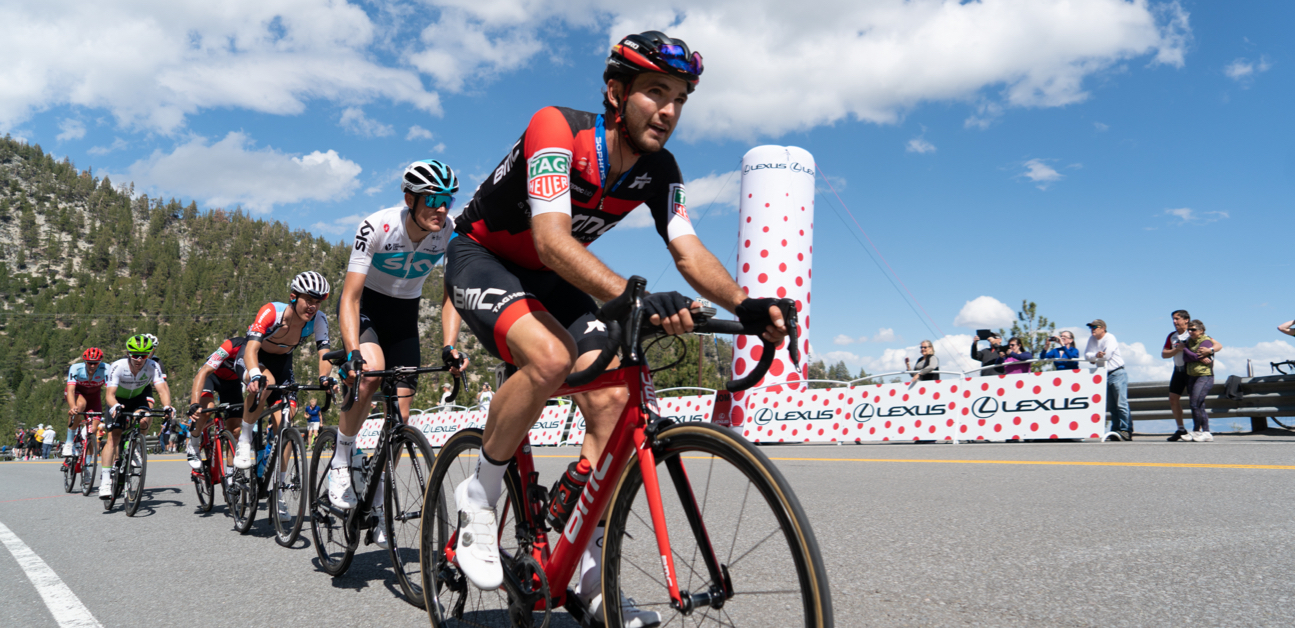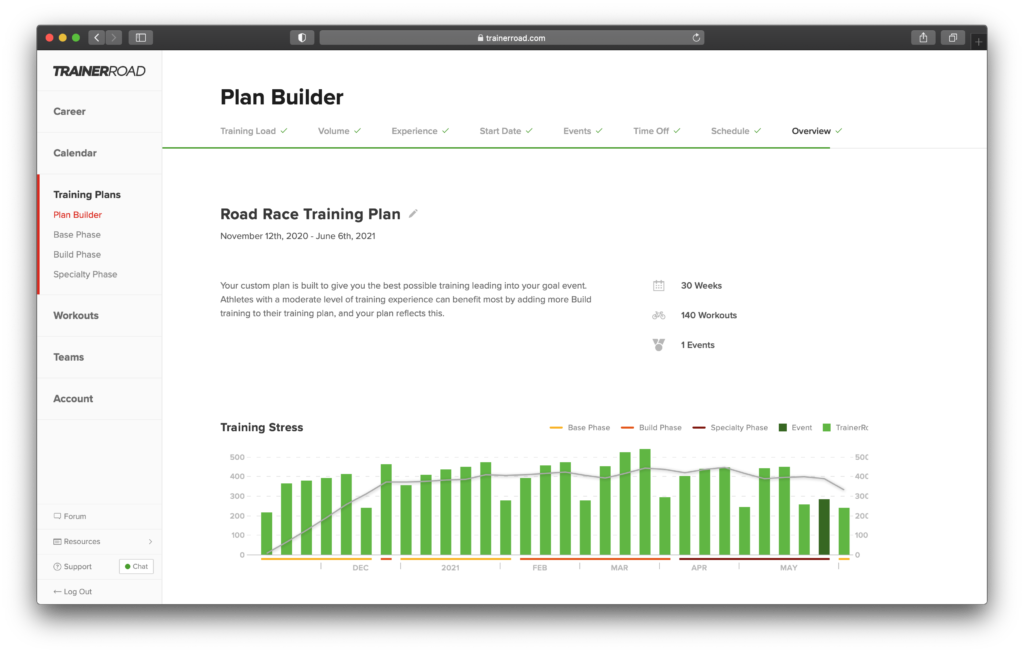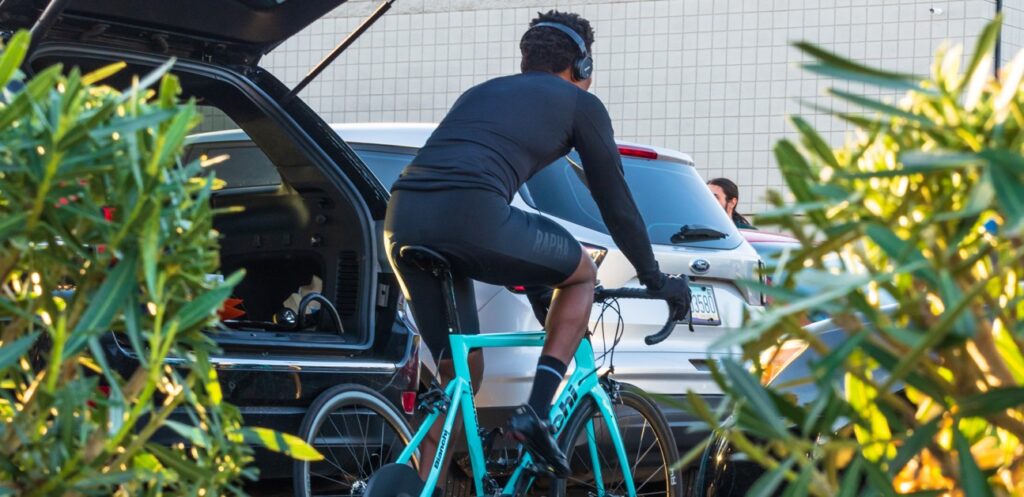Road Racing Guide: How to Be a Faster Road Racer

Road Racing is one of the most diverse and challenging disciplines in cycling. Road events take many forms, and require a specific mix of skill, strategy, and fitness. This article will explain the most common types of road racing, and consider how you can target your training for success in these events.
What is a Road Race?
As a discipline of cycling, “road racing” can include almost any event that occurs on a mostly-paved surface. But the term Road Race does have a more specific definition: a mass-start race that is longer than a criterium.
Road races are extremely variable in length, format, and terrain. The shortest road races are circuit races, which include repeated laps of a 5km to 10km loop and are essentially oversized criteriums. At the long end are events like LoToJa, a 202-mile point-to-point race over 3 mountain passes. Between these extremes are a wide variety of races that can occur on flat, rolling, or mountainous terrain and most commonly cover between 30 and 90 miles.
Training For a Road Race
As with other forms of racing, periodized training that develops your aerobic energy system and sharpens your event-specific fitness is the key to success in road racing. This is easy to achieve by creating a custom plan with Plan Builder.
Adaptive Training
Get the right workout, every time with training that adapts to you.
Check Out TrainerRoadWhat Type of Fitness Do You Need For a Road Race
Because road races are so variable from event to event, specific training for one race can be very different from the appropriate training for another. Flatter and shorter road races usually include many high-intensity efforts interspersed with periods of easier riding in the pack, while hillier events often include sustained threshold efforts.
All road races favor riders with a strong aerobic system and the capacity to generate high power to both initiate and respond to attacks. These abilities begin with Base Training, and are further developed through Build and Specialty Phase training. TrainerRoad has two Road Race specialty plans: the Rolling Road Race plan and the Climbing Road Race plan.
Rolling Road Race
Flat or rolling road races are deceptively challenging events, with highly dynamic power profiles. Competitors usually spend several hours in the pack at Tempo, which requires excellent endurance. They also need the fitness to explosively initiate repeated anaerobic attacks, chase down breakaways with sustained hard efforts, and accelerate up short climbs at high percentages of VO2 max power.
The Rolling Road Race plan addresses all of these top-end abilities over the course of 8 weeks. The first 6 weeks of the plan maintain an even training stress load designed to sharpen your specific fitness. Then, a taper week and final event week bring you to your target race in peak form.
Example Rolling Road Race Workouts

Kern +1 helps raise your aerobic capacity with a variety of efforts that range from well above to slightly below your FTP.

Eclipse improves your muscular endurance and aerobic capabilities through Sweet Spot intervals.

Gabb is one of the most challenging workouts in the plan. Short Anaerobic efforts followed by longer Endurance intervals are a great simulation of what you’ll likely face on race day.
Climbing Road Race
Climbing road races include selective climbs that test your aerobic fitness, and challenging high-speed descents while you try to recover. They also include many of the same intense efforts as flatter races, such as explosive anaerobic attacks and sustained surges at VO2 Max power. Racers need to be able to sustain very high percentages of FTP for periods lasting at least several minutes, and sometimes closer to an hour at a time.
The 8-week Climbing Road Race plan addresses the ability to generate short bursts of power, and develops a rider’s muscular endurance and lactate processing capabilities for long climbs. The plan holds a steady training stress load for 6 weeks of specialized intervals, and then includes lower-intensity taper and race weeks so you’re at your best on race day.
Example Climbing Road Race Workouts

Bradley +1 targets muscular endurance. It forces you to sustain steady power near FTP for a long time, with brief bursts at high power.

Basin +1 develops your ability to work at and above FTP with challenging ramping efforts. These efforts target both aerobic and anaerobic fitness.

Eclipse is a classic Sweet Spot workout, with 3 long efforts just below FTP and some optional form drills.
How TrainerRoad Will Make You a Faster Road Racer
Each of TrainerRoad’s road race training plans includes everything you need to be a faster road racer. You can build a custom road training plan with Plan Builder. Plan Builder will consider your experience, available training time, and goal event to create the perfect road race training plan for you.

Every TrainerRoad training plan includes three distinct training phases that progressively develop your fitness. First, you’ll start with Sweet Spot Base to build your aerobic base. Then, you’ll work on building power with either General Build or Sustained Power Build. Finally, you’ll sharpen your race-specific fitness with one of our Road Race Specialty Plans. With workouts that build sustained power as well as anaerobic capabilities, you’ll be ready to crush the competition in road races.
Nutrition For Road Races
Because most road races last for several hours, nutrition and hydration can easily make or break your results. To add to the challenge, it’s easy to underestimate how much you need ingest during a race, or even to forget to eat entirely. This is why it’s important to develop a strategy to stay fueled and hydrated in advance, so on race day it’s just a matter of following your plan.
Nutrition Before Your Event
The process of fueling your race begins well before you arrive at the start line. During the preceding week, eat wholesome regular meals that ideally include some whole-grain carbohydrates and healthy protein sources. The day before your race, focus on carbohydrate and sodium, but don’t overdo it- add about 30g extra carbohydrate to each meal and around 1200 mg extra sodium to your diet over the course of the day. And the morning of your event, eat a carb-centric meal, low in fat and fiber, about 3 or 4 hours before the race begins. This gives your body ample time to digest and absorb the nutrients it needs.
As your race’s start approaches, keep hydrated but avoid drinking too much within 30-60 minutes of your race for risk of overloading your bladder. 15 minutes before the gun goes off, eat an easy to digest carb source such as a gel, energy bar, or a few dates.
Race Fueling
During the road race itself, fuel yourself continuously with easily digested carbs such as gels, drink mix, or easily digested snacks, and use an electrolyte supplement in your bottles to replace what you lose in your sweat. Your body can only store enough glycogen for about an hour of high intensity riding, so for events longer than this aim to ingest about 60-90 grams of carbs per hour. Early in the race you might not feel too hungry, but failing to fuel during this crucial period will set you back later on. Use a timer or other cue to remind yourself to eat and drink something every 15 to 30 minutes, no matter what.
Experiment with what foods and drink mixes work for you in training, so you can be confident on race day. Road races are often unpredictably paced, and soft foods such as gels have the advantage of being easy to eat even when the racing is intense. Long races often have areas called feed zones in which family members or teammates can hand you food and drink as you pass by. These are especially advantageous in hot climates where it can be almost impossible to carry enough liquids to last for a long event. If your race is more than a few hours and you don’t have anyone with you to hand up bottles, use the largest water bottles you can and keep a third bottle in your jersey pocket for later on.
For more blog posts on nutrition and hydration, click here.
Road Racing Strategy and Tactics
The strategic and tactical challenges of road races are as diverse and wide-ranging as the discipline itself. Short circuit races often play out like criteriums, with repeated surges and constant attacks. Longer races, especially those with selective climbs, often include extended periods of comparatively easy riding as the peloton saves energy for upcoming challenges. Whatever your event, following a few smart principles gives you the best chance for success.
Preparedness
Advance planning goes a long way in road racing. Study the course and identify any major climbs, headwind sections, and technical corners. Consider where you’ll be best suited sheltering and recovering, and which areas might afford an opportunity to attack. For instance, climbs with long flats after them rarely prove decisive as the field is able to catch back on, whereas repeated small hills can offer a great chance to get away.
Preparedness extends to equipment too. Take care of any maintenance well in advance of the race, and use your knowledge of the course’s terrain and weather conditions to make informed judgements about wheel and tire choice. If the pavement is rough, it’s not a great idea to use very thin race tires, and deep wheels can be a liability in windy conditions. Bring a set of spare wheels if you have them; in many races you can deposit them as backup in a vehicle that follows the pack, in case you get a flat tire.
Energy Conservation
The real key to success in road racing is energy conservation, and many races are won by riders who remain anonymously sheltered in the peloton until the decisive moment. This means good pack-riding skills are imperative for any aspiring road racer. Spend as much time saving energy as you can throughout the race, and resist the urge to chase every move. Most attacks are eventually reeled in by the pack, so let someone else do the work whenever possible.
For hilly courses, a great way to save energy is sag climbing. In this technique you start the climb at the front of the pack, but climb slightly more slowly than other riders and gradually drift towards the back of the field. Sag climbing allows you to save energy, especially over repeated climbs during a long day. It works best when the field is still large and is most effective on fairly short climbs. Be careful not to drift too far back, as drifting completely off the back of the peloton will force you to chase back on, negating any energy you saved on the climb.
Breakaways
Many road races are won in sprint finishes, but many are also won from a breakaway – a small group of riders that successfully escapes off the front of the field and maintains their advantage to the finish line.
More often than not, breakaways succeed because the rest of the pack decides to not chase, rather than because of the superior fitness of the attacking riders. This means timing is crucial- the winning move is the one the pack considers “one step too far”, “too fast”, or “not worth chasing”. Establishing a breakaway is always a risk, but the best time to attempt it is when the field is already tired or unsuspecting. Counterintuitively, attacking into a headwind can be a great tactic, as other riders will be less likely to sacrifice themselves to chase.
Whether to chase when other riders attempt a breakaway is a tough call. Consider who the attacking riders are, and whether they’ve already worn themselves out during earlier moves. If the attacking riders are strong and fresh, it’s a much better move to follow, even if it takes some effort to catch them. And when you do get into a breakaway, success depends on everyone’s contribution so keep the pace steady and manageable. Riders who overzealously surge the pace are often quickly dropped, so take short, steady pulls and leave more in the tank for the long haul.
TrainerRoad Race Analysis Videos
Our Race Analysis YouTube playlist is an excellent source of racing advice. With a constantly expanding selection of POV videos with expert analysis, it’s the best way to gain experience from the comfort of home.
How are successful breakaways established? What is the dynamic within the group, and what decisions do riders need to make within a winning move? Find out in this race analysis video.
Sometimes, making it into the breakaway is the easy part. What to do when you get there is the bigger challenge for many riders. What do you do next? Find out in this video.
Road Racing Categories
Road Races are organized by category, which are designed to pit racers of similar abilities against each other. Riders progress through categories by obtaining points assigned based on finishing position.
In the United States, racers begin in the Novice category (formerly known as category 5) and progress to category 1. All on-road disciplines share the same categories, including Criteriums, Time Trials, and Road Races. Stage races afford extra opportunities to achieve points, and skills clinics and Gran Fondos can count for points in some situations, as well. Click here for more on Category Upgrades.
